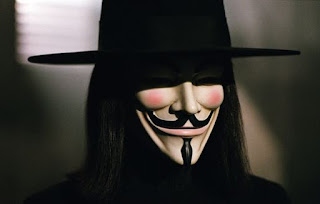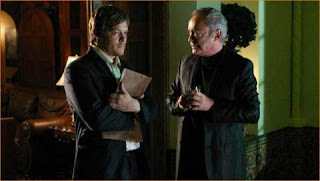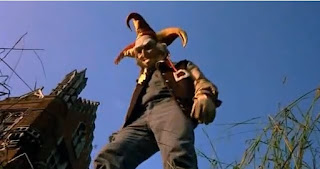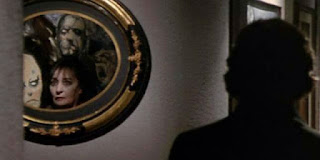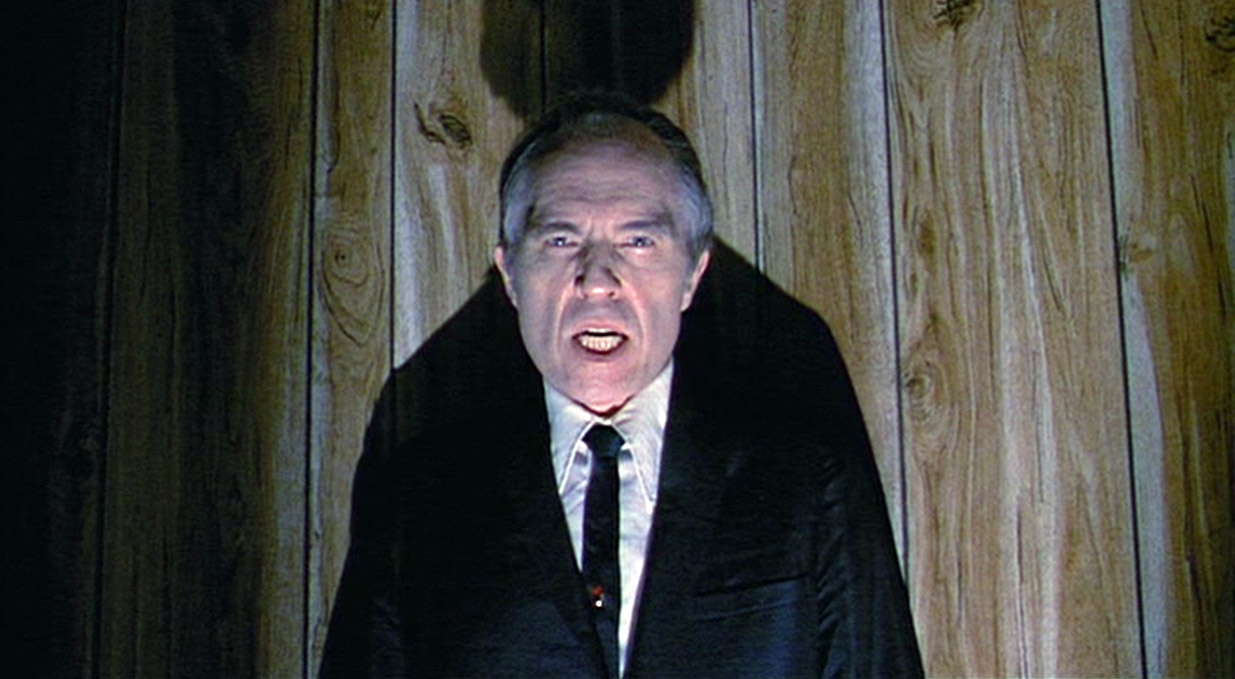There are many features that make movie characters so memorable, their clothes, their physical features and in some cases, the masks they wear. Over the years we have seen a variety of memorable masks on the big screen, from the ones that conceal secret identities to the ones that just make you look scary as hell, masks definitely add to a characters personality and can have an effect on that characters impact on the film. The following list is my pick for the top ten movie masks of all time, it covers a range of films from horror to comic book adaptations, but mainly horror. Enjoy!
10. Baby Mask- Brazil
Terry Gilliam's surreal sci-fi comedy had many memorable scenes, from Sam Lowry's (Jonathan Price) dream sequences to his mother's (Katherine Helmond) questionable cosmetic surgery, Brazil was not a film you'd soon forget. However, one of the most memorable bits for me was the films climax where *SPOILER* Sam's former friend Jack Lint (Michael Palin) proceeds to torture him while wearing a mask that resembles a baby doll's face. It is undeniably a creepy mask and given the time when its used it becomes a lot more unsettling, however due to the darkly comical nature of Palin's character it's not completely unnerving. The mask only makes a brief appearance but its time onscreen is certainly memorable.
9. Hockey Mask- Friday the 13th franchise
Ever since its first appearance in Friday the 13th Part III, Jason Voorhees' hockey mask has become an iconic object in the world of horror cinema. Ever since Jason donned the mask in the third installment of the franchise he has continued to wear it, making it a symbol of both Voorhees and Friday the 13th. Its round, empty sockets and featureless face make Jason seem all the more lifeless and imposing, like some hulking phantom with a machete in hand. Once you lay your eyes on Jason you'll never be able to look at hockey masks the same again.
8. Michael's mask- Halloween franchise
One of the more enigmatic horror movie villains (for a few films anyway), Michael Myers was a characters whose motivations were shrouded in mystery. This hulking man was made all the more imposing by the sinister rubber mask that he wears while slaughtering the babysitters of Haddonfield Illinois. The lifeless, black eyes are what makes it most memorable, Dr. Loomis (Donald Pleasance) at one point even recounts how black Michaels eyes were. Funnily enough, the original Myers mask was actually a William Shatner, James T. Kirk mask that was tweaked a bit to give it its sinister appearance, so the next time you're watching Halloween remember that's William Shatner's face killing all those teens.
7. Translucent mask- Alice, Sweet Alice
A film about a little girl being brutally murdered on the day of her holy communion is a pretty dark concept, especially when the little girls sister Alice (Paula E. Sheppard) is the prime suspect. But what makes this film terrifying is the mask that the raincoat-clad killer wears. It is a creepy, translucent mask that wears a sinister grin, giving the killer a strange doll-like appearance. It is a simple idea but oh god is it creepy as hell, I would consider it one of the more underrated horror movie masks, maybe because the film is not as iconic as the likes of Halloween or Friday the 13th. However, it may be one of the creepiest masks in any horror film I've ever seen.
6. Rorschach's mask- Watchmen
Alan Moore's acclaimed graphic novel Watchmen got its own film adaptation in 2009 where the relentless Rorschach was played by Jackie Earle Haley. Dressed like a noir detective with his trench coat and fedora, Rorschach's most memorable feature is his mask that resembles an inkblot (thus the name Rorschach). The best feature of the mask is that it can change itself depending on Rorschach's mood, how does it do this? Nobody knows but it's very cool. Although Rorschach does claim that this mask is his actual face while his alter ego, Walter Kovac's face is in fact the mask, I think the white inkblot mask better fits this list.
5. Button-eyed mask- Nightbreed
Nightbreed was an adaptation of Clive Barker's story Cabal about a young man who stumbles upon the hidden city of Midian inhabited by monsters. Although it was not as memorable as Barker's claim to fame Hellraiser, one thing about it that you will not forget is the character of Dr. Phillip Decker played by the master of body horror himself, David Cronenberg. Decker was a serial killer who wore one of the coolest masks ever, a sack with a zippered mouth and button eyes, spooky stuff. It is a creepy mask due to its expressionless button eyes and its distorted features and it really made Decker an eerie character, along with his chilling voice. After Pinhead, he could be one of Barker's finest creations.
4. Ghostface- Scream franchise
Wes Craven's meta-horror Scream and its subsequent sequels introduced a new generation to the horror genre and the franchise has since earned its place in the horror hall of fame. One of the reasons why it has become so iconic is its mysterious antagonist Ghostface who dons a ghoulish white mask that is reminiscent of the Edward Munch painting The Scream. Although Ghostface has had multiple identities, the mask has remained consistent and has since become a symbol of terror for the citizens of Woodsborough. It has since become the subject of numerous rip-off Halloween costumes however the original mask is as memorable as the killers sinister voice, provided by Roger L. Jackson.
3. The "killing" mask- The Texas Chain Saw Massacre
The original Texas Chain Saw Massacre saw the insane Leatherface (Gunnar Hansen) wear a variety of masks fashioned out of human skin. Three masks were worn in the original film, the old lady mask, the pretty woman mask and the killing mask, my favourite of the three. The killing mask is the one that Leatherface has become most associated with, human skin stitched together and stretched across his face and earning him his name. One scene in this film that I will never forget involves the mask, it is when Franklin (Paul A. Partain) and Sally (Marilyn Burns) are walking through the woods at night and Leatherface appears out of nowhere with his roaring chainsaw. It is a shocking scene and the sudden appearance of that hideous mask onscreen is one of the most memorable scenes of the film. Out of all of the masks worn by movie serial killers, Leatherface's is by far the greatest.
2. Guy Fawkes Mask- V for Vendetta
Another adaptation of an Alan Moore graphic novel, this time in the form of the dystopian masterpiece V for Vendetta. The protagonist known only as V (Hugo Weaving) wears a grinning Guy Fawkes mask to reflect his anarchistic ways, much like Fakes he wants to take down the system and the mask perfectly represents this. It has since become an iconic image, becoming a symbol of liberation and freedom and can be seen being worn by many an activist. It has also been used by web-terrorist group Anonymous, and has become heavily associated with them. However, the mask has its origins in Moore's story and has gained its popularity from the film adaptation.
1. Vader's helmet- Star Wars franchise
By far the most iconic movie mask of all time belongs to the imposing Darth Vader (David Prowse/James Earle Jones). The mask not only conceals Lord Vader's disfigured face doubles as a breathing apparatus, thus the heavy inhaling and exhaling. It adds to Vader's sinister appearance, the lifeless features of the mask reflect Vader's lack of humanity and how he has become more machine than man. It is a symbol of dread throughout the galaxy and a figurehead for the Empire, Vader's mask is one of the most recogniseable ones in cinematic history and even today remains just as iconic as it did back in 1977.
So that's my pick for the top 10 movie masks, some honourable mentions go to Hannibal Lecter's mask in Silence of the Lamb's and the Phantom's mask in The Phantom of the Opera. If you've got any movie masks that I've left out let me know what your favourite is. Next week there will be more from the Vault of Doom where I'll be talking about the Lucio Fulci film House by the Cemetery, so stay tuned for that.








